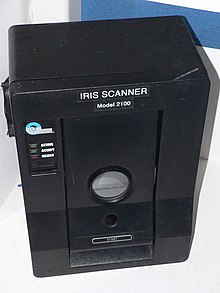Seminar on Iris Scanning
Iris recognition is a method of biometric authentication that uses pattern-recognition techniques based on high-resolution images of the irides of an individual's eyes.
Not to be confused with another, less prevalent, ocular-based technology, retina scanning, iris recognition uses camera technology, with subtle infrared illumination reducing specular reflection from the convex cornea, to create images of the detail-rich, intricate structures of the iris. Converted into digital templates, these images provide mathematical representations of the iris that yield unambiguous positive identification of an individual.

Iris recognition efficacy is rarely impeded by glasses or contact lenses. Iris technology has the smallest outlier (those who cannot use/enroll) group of all biometric technologies. Because of its speed of comparison, iris recognition is the only biometric technology well-suited for one-to-many identification. A key advantage of iris recognition is its stability, or template longevity, as, barring trauma, a single enrollment can last a lifetime.
Reference Material


